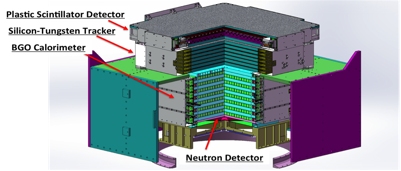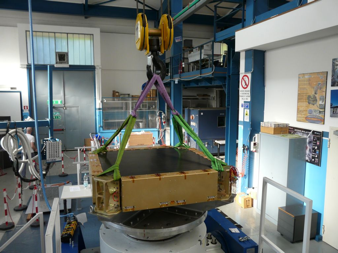DAMPE comes to CERN before going to Space
The evidence that some invisible (“dark”) matter exists in the universe was first observed many decades ago, by the Swiss physicist Fritz Zwicky in 1933, among others, from studying the relative movement of stars and galaxies, and was more recently confirmed by gravitational lensing effects. In spite of many years of search efforts the nature of this Dark Matter (DM) remains a mystery. According to the Standard Model of Big Bang Cosmology (LCDM), DM makes up about 23% of the mass-energy density of the universe. The nature of the Dark Matter has thus become one of the most fundamental questions of modern science, and many experiments have been set up to unravel this mystery in recent years, using either large underground detectors or at colliders (for example the LHC), or with space missions.
The DArk Matter Particle Explorer (DAMPE) is a scientific satellite mission funded by the Chinese Academy of Science. Scheduled to be launched in late 2015, it aims to measure electrons and photons in the range of 5 GeV-10 TeV, with unprecedented energy resolution (1.5% at 100 GeV), in order to detect DM annihilation in these channels. It will also measure the flux of nuclei up to above 100 TeV with excellent energy resolution (40% at 800 GeV), which will bring new insights to the origin and propagation of high energy cosmic rays. With its excellent photon detection capability, the DAMPE mission is well placed for new discoveries in high energy g-ray astronomy as well. The DAMPE collaboration consists of Chinese institutes (Purple Mountain Observatory, Nanjing; University of Science and Technology, Hefei; Institute of High Energy Physics, Beijing; Institute of Modern Physics, Lanzhou; National Space Science Center, Beijing) and European institutes (University of Geneva, INFN Perugia and INFN Bari). DAMPE is a CERN recognized experiment since March 2014.
The DAMPE detector (Figure 1), weighs 1.4 T and consumes 400 W, consists of a plastic scintillator strips detector (PSD) that serves as anti-coincidence detector, a silicon-tungsten tracker-converter (STK), which was proposed by the European groups and is being produced in Europe, a BGO imaging calorimeter of about 31 radiation lengths, and a neutron detector (NUD).

Figure 1. A sketch of the DAMPE detector.
The detector construction is progressing rapidly. The engineering and qualification models (EQMs) of all sub-detectors have now completed and space environmental qualification is in progress (Figure 2 shows the STK EQM being installed for a vibration test).

Figure 2. The DAMPE Silicon Tungsten Tracker Engineering and Qualification Model being installed for vibration test in SERMS, Terni, Italy
DAMPE relies on CERN high energy particle beams to calibrate its detector. In October 2012 the DAMPE BGO engineering model was tested at SPS H4 test beam. In July 2014, some STK ladders were put into the PS T9 beam to study the performance of the silicon strip detectors. Later in October this year, the EQMs of all sub-detector will come to CERN, to be assembled to the full detector, to be put into the beams at T9 and H4 for full calibration with electrons, protons and possibly photons. It is also very likely that the detector will stay at CERN over Christmas in order to profit the argon run of the SPS next Spring to calibrate the detector response to heavy ions. Thanks to CERN, we can look forward to a well-calibrated DAMPE to search for convincing dark matter signatures.
